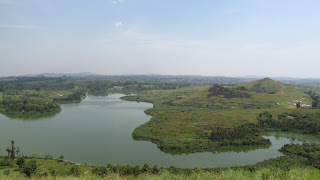Below is a brisk slide show of our visit to the Amabere caves and crater lakes.
Our friendly guide, Apollo, introduced us to the privately owned estate that was previously untouched due to local superstition. Locals believed that evil spirits lurked within the caves until the owner, Yasamu Lubombora, bravely claimed it and developed it into a productive farm and ranch, and now a popular tourism destination.
We crossed several paddocks of grazing land as he unveiled this intriguing story that weaved from myth to science with the dexterity of masterful piece of non-fiction. Listen to the tales, according to Apollo: Amabere Tales #1, Amabere Tales #2, Amabere Tales #3.
In order to reach the caves, we needed to wade through some dense, unspoilt woodland with, however, a beekeeper hive.
Apollo announced a smell of boiled rice that he explained is the smell of a snake and in the same breath showed us a plant that can remedy snake bites ( oh, what a relief!).
We descended into the muddy exterior of the caves. They are the only caves in Uganda with the right combination of water flow and limestone presence to form stalactites and stalagmites. This makes them very well known in the country.
The waterfall of this stream, which flows too fast to allow these formations to happen (and even faster in the rainy season), gushed as if from nowhere under thick bush into a clear pool.
In fact, in the rainy season it would have been impossible to stand on the stepping stones keeping me above the splash pool. They would have been submerged!
The Breasts of Nyinamwiru, the curious name for stalactites whose crystallisation ceased a long time ago.
Some inactive stalactites still dripping groundwater into a pool below.
This harmless bush used for fencing farmland, has a poisonous sap within.
Mature bamboo forest.
We did a 2 hour walk across a series of crater lakes, some summiting at about 1,500m. We observed the scenery of numerous crater lakes, farms and commercial pine forests.
The caldera of this extinct volcano has deceptive jungle and marshland that hides quicksand. We skirted its rim as we toured the area.
Some compost burning over grassland that is not fertile enough to grow crops but good enough for ranching and forestry.
A lone lucky bean tree in full bloom on the slopes of this crater lake. There were actually many of these dotted around the area.
This eco-tourism site is named after the Bunyoro princess with the famous breasts that I described earlier :-).
Two geckos trying to keep cool and invisible.
Playtime in the marsh! Now, enjoy the remaining crater lake scenes...
---------------------------------------------------------------
1/530 George Padmore Road, Kilimani,Nairobi, Kenya
Mobile: +254 722 987846 / +254 736 280607
Telephone : +254 205220 569
PO Box: 21449 – 00505, Adams Arcade - Nairobi Kenya

























No comments:
Post a Comment